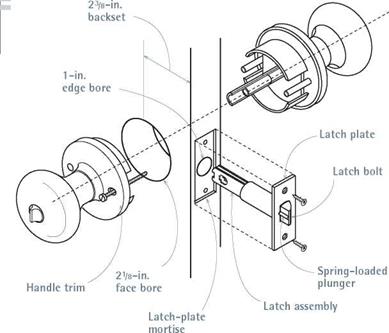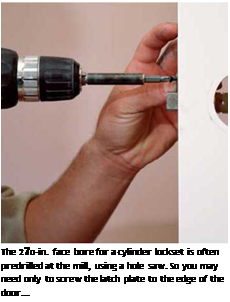CYLINDER LOCKSETS
Cylinder locksets (also called tubular or key-inknob locks) are popular because they’re cheap and easy to install. Better models have a spring – loaded dead latch that prevents the bolt from
DEAD B
![]()

 Exterior doors should have a dead bolt with a minimum 1-in. throw (extension) and a reinforced strike plate that screws into the framing behind the door frame. Single-cylinder deadbolts have a thumb-turn on the interior that is easy to open in the event of a fire. Unfortunately, such thumb-turns can easily be turned by a burglar breaking a glass side light. Double-cylinder models, which require a key on both sides, are more secure but are frequently banned by fire codes.
Exterior doors should have a dead bolt with a minimum 1-in. throw (extension) and a reinforced strike plate that screws into the framing behind the door frame. Single-cylinder deadbolts have a thumb-turn on the interior that is easy to open in the event of a fire. Unfortunately, such thumb-turns can easily be turned by a burglar breaking a glass side light. Double-cylinder models, which require a key on both sides, are more secure but are frequently banned by fire codes.





being retracted by slipping a plastic credit card between the door edge and the frame. But no cylinder lock is secure, because all can be snapped off with a pry bar or a swift kick. To be safe, install a dead bolt, too.
1. Using the template supplied by the manufacturer, mark the centers of holes to be drilled into the face of the door (face bore) and the edge (edge bore). Use a 2f8-in. hole saw to drill the face bore. But after the tip of the hole saw bit emerges on the other side, prevent splitting by backing the bit out and finishing the hole by drilling from the other face.
2. Use a 18-in. spade bit to drill the edge bore, keeping the bit perpendicular to the edge. (Buy or rent a boring jig if you have a lot of locks to install.) Insert the latch/bolt assembly into the hole and use a utility knife to trace around the latch plate. Rout the inscribed area so that the plate is flush to the edge of the door.
3. Screw down the latch plate and insert the lock mechanism through the latch assembly. Try the handle; it should turn freely. Next, position the
strike plate on the jamb. To locate the strike plate exactly, rub a pencil on the end of the latch bolt, shut the door, and release the bolt against the jamb.
4. Using a 18-in. spade bit, drill a latch hole Я in. deep into the jamb. Center the strike plate over the hole and trace around it with a utility knife. Use a router to mortise the strike plate. Note: When the door is shut, the latch bolt should descend into the strike plate hole; the small spring-loaded plunger next to the latch bolt should not. Rather, the plunger should be stopped short by a lip on the strike plate.
5. For greater security, install a unit with a strike-plate reinforcer and З-in. mounting screws. To install the reinforcer, you’ll need to drill through the frame jamb into the framing behind; likewise, the extra-long screws will grab the framing.
Air infiltration (drafts) can account for 20 percent to 30 percent of the total heat loss of an insulated house. If your budget is tight, caulking gaps and installing weatherstripping should be your first priority, even before insulating. The single most crucial piece of weatherstripping is a tight-fitting door threshold.






Leave a reply